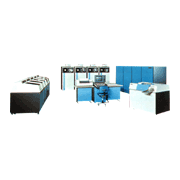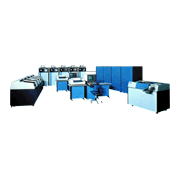In the 1970s, Japan’s computer makers formed three groups to take advantage of grants from the Ministry of International Trade and Industry. The Mitsubishi Electric–Oki Electric group developed the COSMO mainframe series using one the Ministry of International Trade and Industry’s grants and announced the series’ first model, the Model 700, in 1974. The COSMO series maintained backward compatibility with the MELCOM 7000 series. However, compared to the MELCOM 7000 series, the COSMO series offered better reliability and performance in a smaller physical package thanks to its use of generic LSI chips and microprogram control. The machines also lowered CPU loads by boosting the intelligence of the local I/O processor (LIOP) and provided enhanced RAS (reliability, availability, and serviceability) functions with error correction functions for main memory and disk devices.
Main memory of between 64 kilobytes and 1,024 kilobytes could be installed in the machines. Although the word length was 32 bits, the read width was 64 bits. Eight-bit ECC codes were added as well. The cycle time was 0.9 microseconds.
The CPU was controlled by microprograms. One word of the microprogram was 108 bits long, and one microinstruction took 170 nanoseconds to execute.
To implement virtual memory, a 256-word IC memory unit, called a table translation buffer, was used for address translations. Address translations were performed in one clock cycle using set associative caching.
The machines’ multiplexer I/O processor (LIOP) was implemented as a local processor with improved intelligence that was independent from the CPU and covered the local processing for the CRT console and communication lines in addition to connecting to low-speed I/O devices. Microprograms for the LIOP had a word length of 16 bits. The LIOP had a 256-word ROM for loading the initial microprogram and an 8,000-word RAM where microprograms to handle I/O devices resided.
The machines had a general I/O processor (GIOP) as well with two data transfer modes: a burst mode and a multiplex mode. The burst mode was used with high-speed I/O devices and occupied the GIOP during the transfer of one block, reaching transfer speed of 2.0 megabytes per second. In the multiplex mode, the GIOP transferred between several to 16 bytes at one time and reached a maximum transfer speed of 1.3 megabytes per second. When an error occurred with an I/O device, the hardware would retry the I/O instruction without the intervention of the operating system.
UTS/VS, an operating system developed for the COSMO Series, employed the multiple virtual memory system to provide independent virtual memory for each user. It provided support for batch processing, time-sharing processing, real-time processing and remote batch processing (which had been supported in the MELCOM 7000 Series) as well as on-line transaction processing, and achieved 5-dimensional multiprocessing.
In 1976, the two companies announced the Model 700II to replace the Model 700 and the Model 900 as the high-end model.
The features of the Model 700II included higher mounting density and lower power consumption because the main memory unit used 4-kilobit IC memory chips; main memory extensibility (up to a maximum of 3 megabytes); higher processing speeds due to overlapping instruction execution and instruction prefetching made possible by advanced microprogramming technology; and the capability to withstand power-supply interruptions and power outages thanks to a backup battery and associated circuitry.
The Model 900 was a multiprocessor system with a shared main memory unit. As such, it could be used as a core computer in a computer network that connected multiple computers via communication lines. The Model 900 also offered excellent cost performance because it employed microprogram technology and high-performance LSI circuitry.



